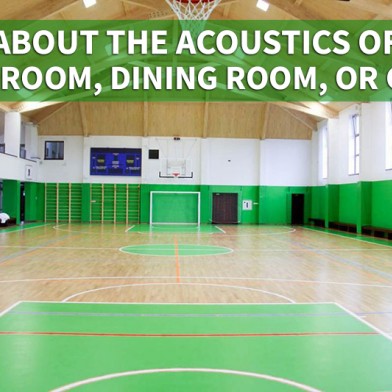How about the acoustics of a classroom, dining room, or gym?
- 17 October 2022 23:16:35
- Reviews: 0
- Views: 288
-

The importance of acoustic well-being is often underestimated when designing a new or existing space. This often happens in workplaces with day-to-day operations, such as school cafeterias, student classrooms, or high-ceiling sports halls.
Problems with acoustic discomfort or excessive noise and echo. However, they begin to apply only after moving to new places, where it turns out that the conditions for work and other activities are not very suitable. While they tend to talk about larger interiors such as open offices, dining rooms, foyers or foyers, the much bigger problems tend to lie in the smaller ones. In such spaces, for example, mutual shouting, the incomprehensibility of projected videos, and the like are felt more. These small spaces are mostly used as conference rooms or private offices, so there is an increased sensitivity to the above. And you don't even have to be a trained builder with a diploma to figure out that in an office with a completely smooth, even surface, every word and every second sound will sound like a cave. Such conditions then affect both work morale and worker resilience and productivity.
Modern and popular glass, concrete, metal or drywall are completely acoustically unsatisfactory materials. Although they are very affordable and at first glance really beautiful, they do not guarantee acoustic well-being. Today we can see them in up to 90% of large companies, where they are used as walls and partitions when dividing rooms.
However, this applies not only to offices, these problems also affect modern residential buildings. Most of them are built in an open space style, often glazed and combined with plasterboard or tiled floors. All conversations, phone calls and more echo throughout the house and privacy is suddenly lost.
So what's the solution?
Is it possible to solve these problems without interfering with the design? So that there is no extra mess? Is it even possible to solve them without interrupting the traffic, and also in such a way that the whole room remains attractive? For a successful acoustic setup of the room, it is most effective to start from the ceiling, which may not be as difficult as it seems.
Savior named melamine.
Melamine. Resin, from which foam blocks can be made, is becoming more and more useful today. From these blocks, we can cut tiles of almost any shape. Non-flammable, well sound-absorbing melamine moldings are very light. Such fittings with dimensions of 100x100x4.5 centimeters weigh approximately 200 grams. Melamine boards are very easy to cut, boards up to 5 centimeters thick are not damaged even by vaulted ceilings, as they are flexible to a certain extent.
With a thickness of 4-5 cm, the melamine panel has satisfactory absorption coefficients already at a frequency of 315-500 Hz. When we talk about everyday classic sounds such as the creaking of chairs, the hum of electronics or the human voice, this sentence is more than enough. For better clarity, we recommend a series of videos with examples before and after the installation of melamine sound insulation, a link to which you can find at the end of the article.
How is the situation with melamine in practice?
Thanks to its discreet white or gray color, it fits almost anywhere. It is versatile and very unobtrusive, besides, to improve the acoustics, it is enough to cover only 50% of the ceiling area. The installation is very fast and silent, so it can be carried out even during normal operation.
Installation three times in different ways.
The most common forms of mounting involve gluing 100x100cm boards or other suitable pieces to the ceiling. For gluing, we use a quick-drying foam adhesive, which is applied to the boards in small quantities. Thus, the plates can be easily removed at any time and reused elsewhere.
Another installation option is hanging boards, which not only work great, but can also be a very interesting and stylish addition. Suspended acoustic elements are practical for interiors with high ceilings. Due to the lightness of the melamine boards, there is no need to directly drill the hanging hooks, just glue them on. For example, Mamut glue can be a great gluing aid. This distinguishes little-known melamine from heavy multilayer acoustic panels. They are difficult and expensive to install and can be very dangerous if torn off.
If we are dealing with an already manufactured raster cassette ceiling, a third type of installation is offered. Melamine cassettes can only be inserted into the grid instead of the existing ones, again, only 40-50% of the area will suffice.
And where better not to put ...
Melamine is not a material that can be wiped down with a damp cloth if it gets dirty. Therefore, we do not recommend placing it on walls where anyone can reach and thus stain or directly damage the slabs. Therefore, the use of melamine panels is mainly suitable for ceilings. Not only because of the better effect, but also for this practical reason.
Are there alternatives?
A much cheaper and not always reliable relative of melamine foam is standard polyurethane acoustic foam. Available only in dark gray, which makes it not very aesthetic. Another disadvantage is its incomplete incombustibility. We can see such foam mainly in recording studios, music rehearsal rooms or clubs.
Acoustic comfort after installation.
After improving your acoustic well-being, you will understand each other better in offices, the sound will become focused, the echo will decrease, and you will immediately be able to work better. Since less acoustic energy will be loaded, the overall noise level will be reduced. We are talking about 3-6 dB, which in practice is quite audible effect. In a word, the space will become quieter, and you will feel much more comfortable.


